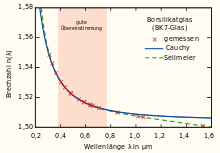Cauchy's equation
The Cauchy equation , also known as the Cauchy model , is a mathematical description of the dispersion of electromagnetic waves in solids over a large spectral range. It is mostly used in the area of visible light. The empirically determined relationship was published by Augustin-Louis Cauchy in 1830 .
description
The Cauchy equation is a parametric description of the refractive index of a material as a function of the wavelength in the form:
| material | A. | B in μm 2 |
|---|---|---|
| Quartz glass | 1.4580 | 0.00354 |
| Borosilicate glass (BK7) | 1.5046 | 0.00420 |
| Crown glass (K5) | 1.5220 | 0.00459 |
| Barium crown glass (BaK4) | 1.5690 | 0.00531 |
| Barium flint glass (BaF10) | 1.6700 | 0.00743 |
| dense flint glass (SF10) | 1.7280 | 0.01342 |
For most materials, however, the first two members of the series are sufficient to describe the measured dispersion sufficiently well in a limited spectral range. For this reason, only the parameters A, B, C are often given for the description; this also applies to many optical simulation and analysis programs such as those used in ellipsometry , for example. The following applies:
However, the description only applies to isotropic, almost ideally transparent materials. That is, the extinction coefficient in the complex refractive index is very small. In order to describe the transition range to a spectral range with absorption sufficiently well, the Cauchy equation can be extended by a wavelength-dependent term for the extinction coefficient:
where , and represent corresponding adjustment parameters. For the simulation of birefringent , i.e. optically anisotropic materials, some analysis programs also offer additional model extensions.
validity
As already described, the Cauchy equation is only valid in a limited spectral range. The material described must not have any absorption bands in this area, for example caused by band transitions . Therefore only transparent materials can be written on with sufficient accuracy. Physical effects such as anomalous dispersion as they occur in the area of absorption centers and also the absorption behavior itself cannot be described, therefore no metals either.

Wolfgang von Sellmeier published an expanded empirical model in 1871, which is named after him the Sellmeier equation . It models the refractive index better in the ultraviolet and infrared. However, this description is also limited to wavelengths in which the material is transparent. An improved description of the refractive index for metals followed at the end of the 19th century with the Drude model for metals by Paul Drude . Hendrik A. Lorentz managed to combine the approaches of Drude and Sellmeier with the model of the Lorentz oscillator .
literature
- DY Smith, Mitio Inokuti, William Karstens: A generalized Cauchy dispersion formula and the refractivity of elemental semiconductors . In: Journal of Physics: Condensed Matter . tape 13 , no. 17 , 2001, p. 3883-3893 , doi : 10.1088 / 0953-8984 / 13/17/309 .
- AL Cauchy: Mémoire sur la dispersion de la lumière . JG Calve, 1836 ( full text in the Google book search).
Individual evidence
- ↑ Augustin-Louis Cauchy: Sur la refraction et la reflection de la lumière . In: Bulletin de Férussac . No. 14 , 1830, p. 6–10 ( PDF on Galica ).








